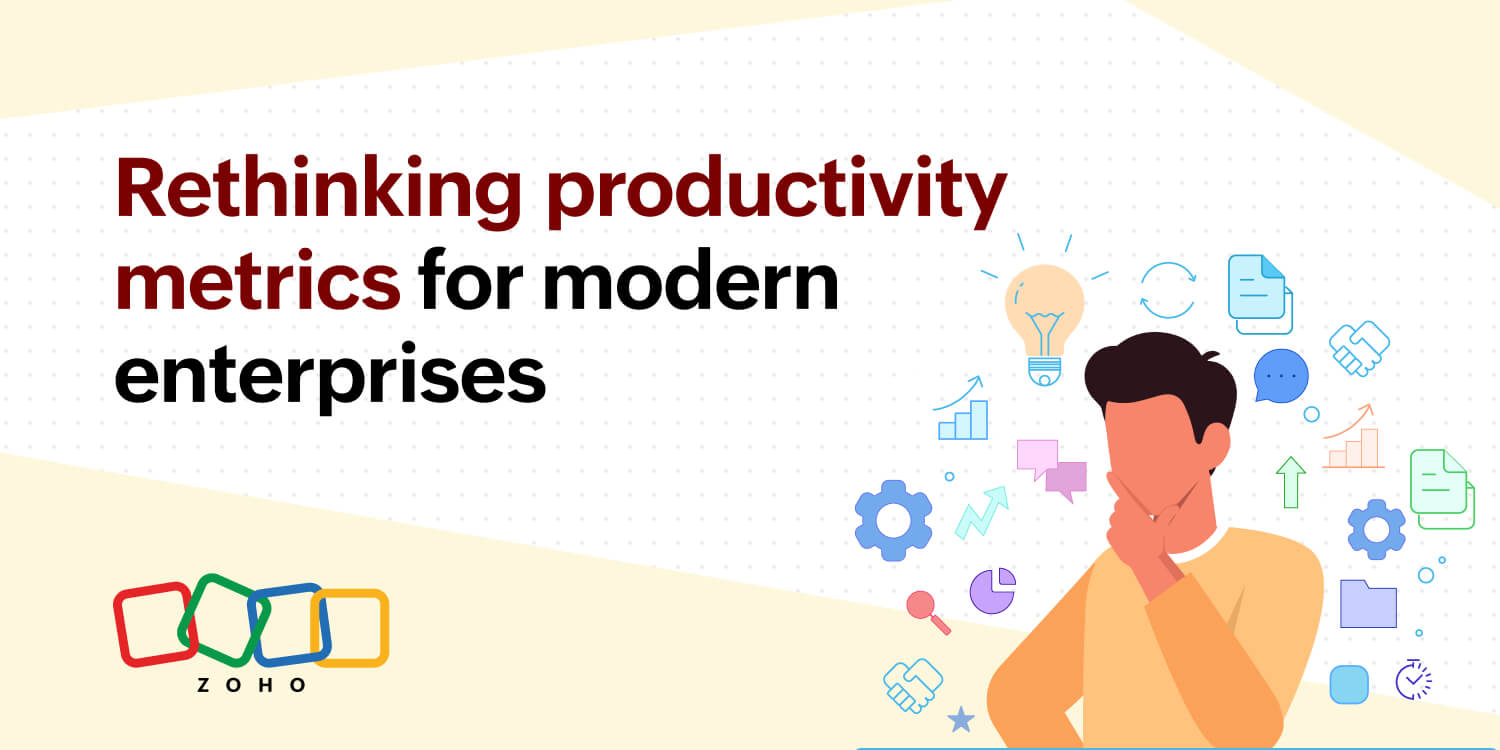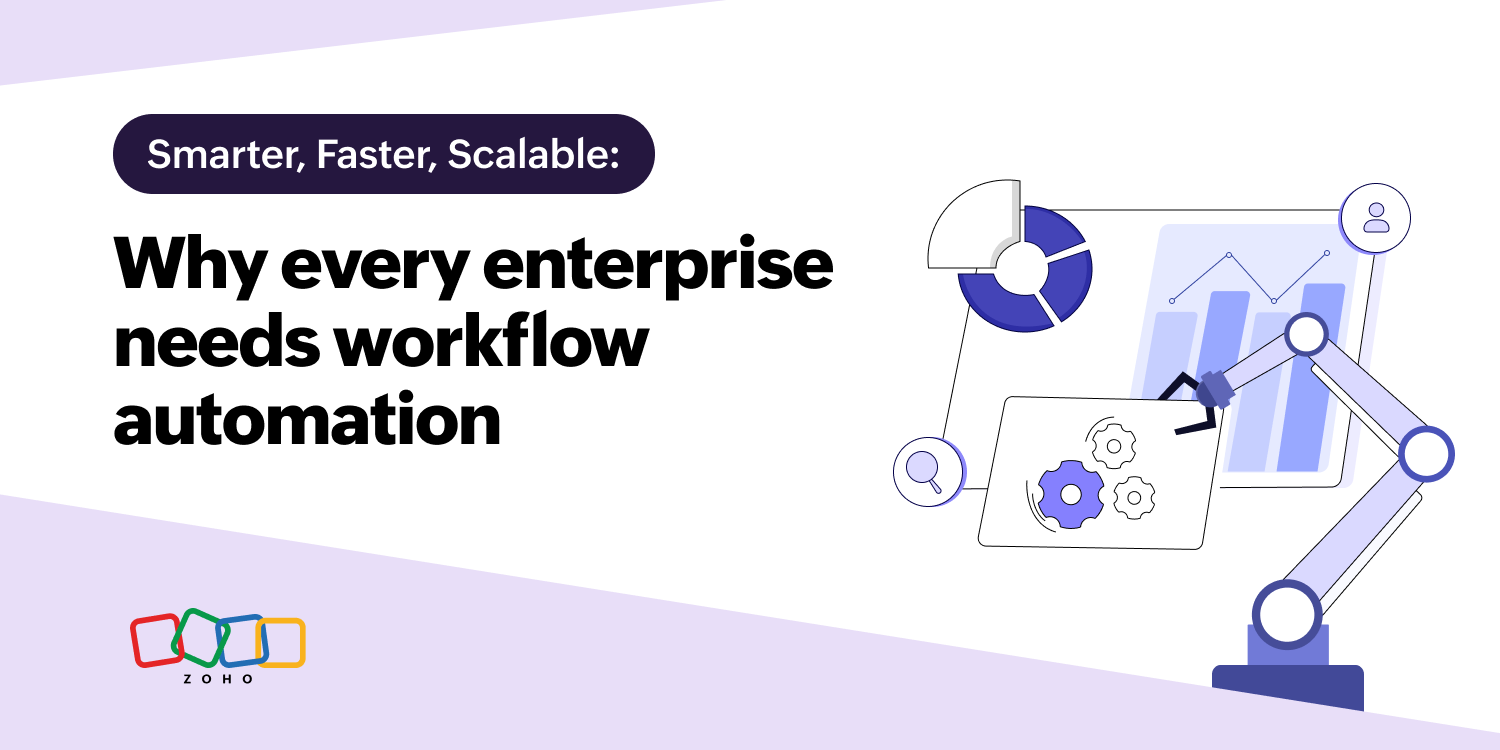- HOME
- All Topics
- Productivity in the workplace
- Rethinking productivity metrics for modern enterprises
Rethinking productivity metrics for modern enterprises
- Published : October 27, 2025
- Last Updated : October 27, 2025
- 181 Views
- 7 Min Read

When was the last time you felt truly productive at work? Was it because you cleared your inbox, attended back-to-back meetings, or because you actually accomplished something meaningful?
For decades, productivity has been reduced to numbers: hours logged, tasks checked off, reports filed. It's tidy and easy to measure, but it's also misleading. Many employees find themselves busy rather than truly productive, racing to meet metrics that don’t necessarily create impact.
In modern workplaces, and especially in enterprises where teams are large, distributed, and heavily interdependent, traditional measures fall short. Is an employee who spends ten hours on a spreadsheet more productive than one who spends two hours brainstorming a breakthrough idea? By conventional metrics, the answer is yes. But by any real measure of value, the answer is probably no.
This disconnect is at the heart of the problem. Enterprises need to rethink how they define and track productivity. In an era where knowledge, collaboration, and creativity drive growth, the old yardsticks don’t just miss the mark; they risk pointing organizations in the wrong direction.
The question isn’t “How much are we doing?” anymore. It should be “How much of what we’re doing truly matters?”
The problem with traditional metrics
Traditional productivity metrics, such as hours worked, number of tasks completed, or attendance at meetings, were designed for a different era. They worked reasonably well when work was manual, repetitive, and output was visible and measurable. But in today’s enterprise workplaces, these metrics often capture activity rather than actual value.
Take emails, for example. An employee who responds to 50 messages in a day may appear productive. But if those emails don’t advance a project, what have they really achieved? Similarly, sitting through long meetings might check the box for engagement, but it doesn’t guarantee that meaningful outcomes are being delivered.
Another common yardstick is hours logged. Many organizations still equate long workdays with dedication and productivity. Yet, countless studies show that more hours don’t necessarily translate into better results; sometimes they just lead to burnout. In large enterprises, this problem is compounded because employees may feel pressured to be “seen as working” rather than actually making progress.
The issue with these traditional measures is that they reward visibility over value. They highlight how much effort is put in but overlook whether that effort is directed toward impactful outcomes.
It’s not that these metrics are entirely useless; they still offer some operational insight. But on their own, they no longer tell the full story of what productivity means in modern enterprises.
Shifting enterprise needs
Modern enterprises don’t look like they did even a decade ago. Teams are spread across geographies, employees collaborate virtually as often as they do in person, and knowledge, not manual output, has become the core driver of value. In this environment, measuring productivity by traditional yardsticks leaves too much of the picture blank.
Hybrid work has made this gap especially visible. When employees aren’t physically present, counting hours in the office or face time in meetings no longer works as a reliable measure. What matters instead is the quality of collaboration, the outcomes of projects, and how effectively teams bridge time zones and departments to deliver results.
Enterprises also face challenges unique to their scale. Multiple departments working in silos can easily fall into the trap of looking “busy” without producing impact. A report might be finished, a dashboard updated, or a meeting held but unless these activities connect to larger business goals, they don’t add up to true productivity.
Research reflects this shift, too. A recent Deloitte study noted that over 70% of enterprises see collaboration and innovation as the new cornerstones of productivity, rather than hours worked. Employees themselves echo this sentiment, with many reporting that their most productive days are when they solve problems or move key initiatives forward, not when they simply check items off a to-do list.
The message is clear: As the nature of work evolves, so must the way enterprises measure productivity. The challenge now is to define metrics that capture not just activity but impact, and that’s where new dimensions of productivity begin to emerge.
What new productivity could look like
If the old metrics don’t tell the full story, what should enterprises measure instead? Productivity today is less about “how much we do” and more about “how much of it actually matters.” Here are a few ways to look at it differently.
Collaboration that works
Most work in enterprises happens across teams, not in silos. But we often measure meetings instead of outcomes. A better question is: Did those meetings help the team move forward? For instance, a product launch is more successful when marketing, design, and engineering work seamlessly together no matter how many or how few meetings it took.
Ideas and problem-solving
Checking tasks off a list is important, but it’s fresh ideas that push companies ahead. Think of a support team that figures out a faster way to solve recurring customer issues. That kind of problem-solving creates lasting impact, but it rarely shows up in traditional metrics. The same Deloitte study cited above even noted that innovation is now a top productivity driver for large organizations.
Well-being as part of the equation
It’s hard to be truly productive when you’re running on empty. Enterprises are starting to pay attention to burnout rates, engagement, and overall team morale. A group that delivers results without sacrificing balance is far more sustainable than one that’s constantly sprinting toward deadlines.
The customer’s perspective
Enterprise productivity should tie back to customer value. Did the work improve satisfaction, reduce churn, or make the experience smoother? For example, a support agent who resolves fewer tickets but leaves customers happier may be contributing more than someone who races through twice as many.
Ability to adapt
Change is constant. The faster a team can learn new tools, adjust to new priorities, or pivot when plans shift, the more productive they really are. In fact, Gartner research highlights adaptability as one of the strongest predictors of long-term enterprise performance.
These aren’t replacements for traditional metrics, but they expand the picture. Instead of only tracking what gets done, enterprises can also look at how it gets done and what difference it makes.
Examples of evolved metrics
Many enterprises are already rethinking how they measure productivity. These examples show how metrics can shift to reflect real value:
From hours to outcomes
Instead of tracking overtime or hours worked, some organizations now measure project milestones delivered on time. The Deloitte survey found that outcome-based metrics improved efficiency by nearly 20%, as employees focused more on delivering value than clocking hours.
From ticket counts to customer satisfaction
Support teams traditionally measured productivity by the number of tickets closed per day. Shifting to customer satisfaction scores (CSAT) revealed that agents who solved fewer cases but delivered consistently better experiences had a stronger impact on retention aligning with Gartner’s finding that 80% of customers will switch brands after more than one bad experience.
From task completion to problem-solving impact
In administrative roles, productivity was often tied to the volume of tasks completed. By reframing it around how effectively recurring problems were prevented or streamlined, teams not only reduced repeat work but also cut process bottlenecks. A McKinsey study shows that workflow automation of this kind can boost enterprise productivity by 15% to 25%.
From attendance to engagement quality
Simply attending meetings doesn’t guarantee contribution. Some enterprises now measure engagement by tracking actionable follow-ups after discussions.
These shifts show that evolving productivity metrics aren’t about discarding numbers. It’s about choosing numbers that reflect meaningful progress and enterprise-wide value.
The risks of over-metrics
While evolving productivity metrics can provide better insights, there’s a fine line between measurement and micromanagement. Tracking too many KPIs or focusing excessively on numbers can backfire, leading to confusion, stress, or even counterproductive behaviors. For example, a team overwhelmed with multiple performance dashboards might spend more time updating spreadsheets than actually solving problems.
Over-metrics can also create a culture where employees optimize for numbers rather than outcomes—closing more tickets, attending more meetings, or logging extra hours, but without delivering meaningful impact. In knowledge-driven enterprises, this risk is particularly high, as intangible contributions like creativity, collaboration, and problem-solving are harder to quantify.
To avoid these pitfalls, enterprises can:
Prioritize key metrics:
Focus on a handful of measures that truly reflect impact.
Balance quantitative and qualitative data:
Combine numbers with peer feedback, customer satisfaction, and outcome-based evaluations.
Regularly review metrics:
Ensure they remain relevant as goals and work contexts evolve.
Encourage purpose over pressure:
Emphasize why the metrics matter, not just what they are.
By being mindful, enterprises can gain valuable insights without turning metrics into a source of stress.
Conclusion
Redefining productivity in modern enterprises isn’t just about changing numbers on a dashboard, it’s about shifting mindset. Traditional metrics like hours worked, tasks completed, or meetings attended no longer tell the full story. Today, collaboration, problem-solving, adaptability, and customer impact matter just as much, if not more.
Enterprises that embrace these dimensions and balance them with well-chosen quantitative measures can better capture real value while fostering employee engagement and well-being. But they must be cautious not to overcomplicate measurement systems.
The journey toward meaningful productivity is ongoing. There isn’t a one-size-fits-all solution, and each organization will need to tailor its approach to its culture, goals, and teams.
How does your organization measure productivity today? Are your metrics helping employees focus on what truly matters, or are they just checking boxes? Share your thoughts and experiences, and let’s explore what modern productivity can really look like together.
 Revathi Selvaraj
Revathi SelvarajRevathi is a product marketer at Zoho Workplace. She writes about topics related to workplace collaboration, productivity, and personal development. Outside of work, she enjoys painting, cooking, and occasionally laughing at her own jokes, all while embracing the present moment.


